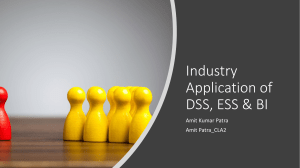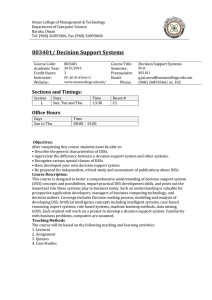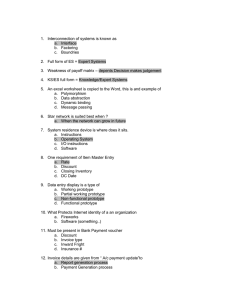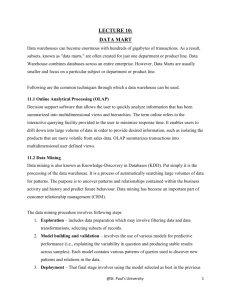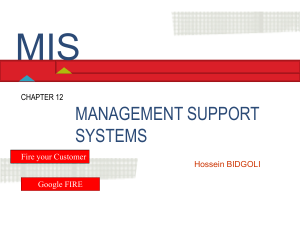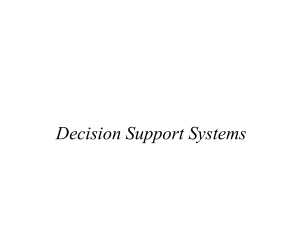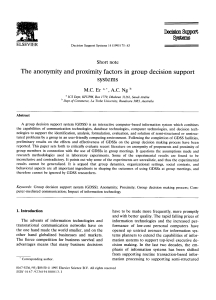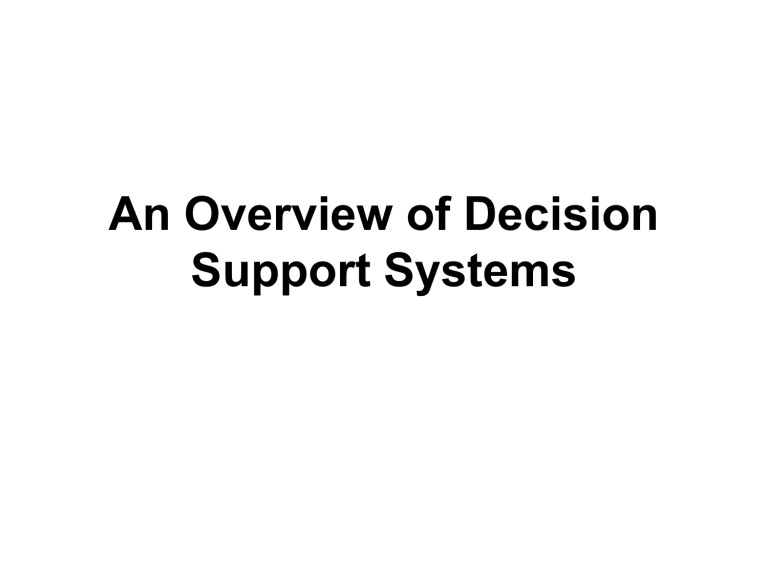
An Overview of Decision Support Systems Capabilities of a Decision Support System (1) • Support for problem-solving phases – Intelligence, design, choice, implementation, monitoring • Support for different decision frequencies – Ad hoc DSS: Concerned with decisions that come up once in every 5 years (e.x., where should a company open a new distribution center?) – Institutional DSS: Concerned with decisions that repeat (e.x., what should the company invest in? Capabilities of a Decision Support System (2) • Support for different problem structures – Highly structured problems: Known facts and relationships – Semi-structured problems: Facts unknown or ambiguous, relations vague – E.x.Which person to hire for a position? • Support for various decision-making levels – Operational level: Daily decisions – Tactical level: Planning and control – Strategic level: Long-term decisions Support for Various Decision-Making Levels Selected DSS Applications Comparison of DSSs and MISs Components of a DSS Conceptual Model of a DSS The Database • Data in databases, data marts, warehouses • Use data mining to help with the decisions • Ex. Who should an airline target for flights from Istanbul to Ankara? The Model Base • Decision makers perform quantitative analysis on data • Model base contains a list of models for mathematical computations • Model management system: Allows access to such models The Model Base Group Decision Support Systems Configuration of a DSS Characteristics of a GDSS (1) • Special design: – Effective communication – Group decision making • Ease of use • Flexibility – Accommodate different perspectives • Anonymous input – Individuals’ names are not exposed • Parallel communication Characteristics of a GDSS (2) • Decision-making support – Delphi approach: Decision makers are scattered around the globe – Brainstorming: Say things as you think---think out loud – Group consensus approach: The group reaches a unanimous decision (everybody agrees) – Nominal group technique: Voting • Reduction of negative group behavior – A trained meeting facilitator to help with sidetracking • Automated record keeping Examples of GDSS Software • Lotus Notes – Store, manipulate, distribute memos • Microsoft Exchange – Keep individual schedules – Decide on meeting times • NetDocuments Enterprise – Two people can review the same document together GDSS Alternatives The GDSS Decision Room Executive Support Systems The Layers of Executive Decision Making Executive Support Systems (ESS) in Perspective • Tailored to individual executives – Not to managers in other levels • • • • • • Easy to use Drill down capabilities Support need for external data Can help when uncertainty is high Future-oriented Linked to value-added processes Capabilities of an ESS (1) • Support for defining an overall vision – Organization’s product lines and services • Support for strategic planning – Predict future trends – Analyze merger possibilities • Support for strategic organizing & staffing – Choice of departments – Pay raises Capabilities of an ESS (2) • Support for strategic control – Monitor and manage the overall organization • Support for crisis management – Put together a contingency plan Summary • Decision-making phase - includes intelligence, design, and choice • Problem solving - also includes implementation and monitoring • Decision approaches - optimization, satisficing, and heuristic • Management information system - an integrated collection of people, procedures, databases, and devices that provide managers and decision makers with information to help achieve organizational goals Summary • Decision support system (DSS) - an organized collection of people, procedures, software, databases, and devices working to support managerial decision making • Group decision support system (GDSS) - also called a computerized collaborative work system, consists of most of the elements in a DSS, plus software needed to provide effective support in group decision-making settings • Executive support systems (ESSs) - specialized decision support systems designed to meet the needs of senior management
